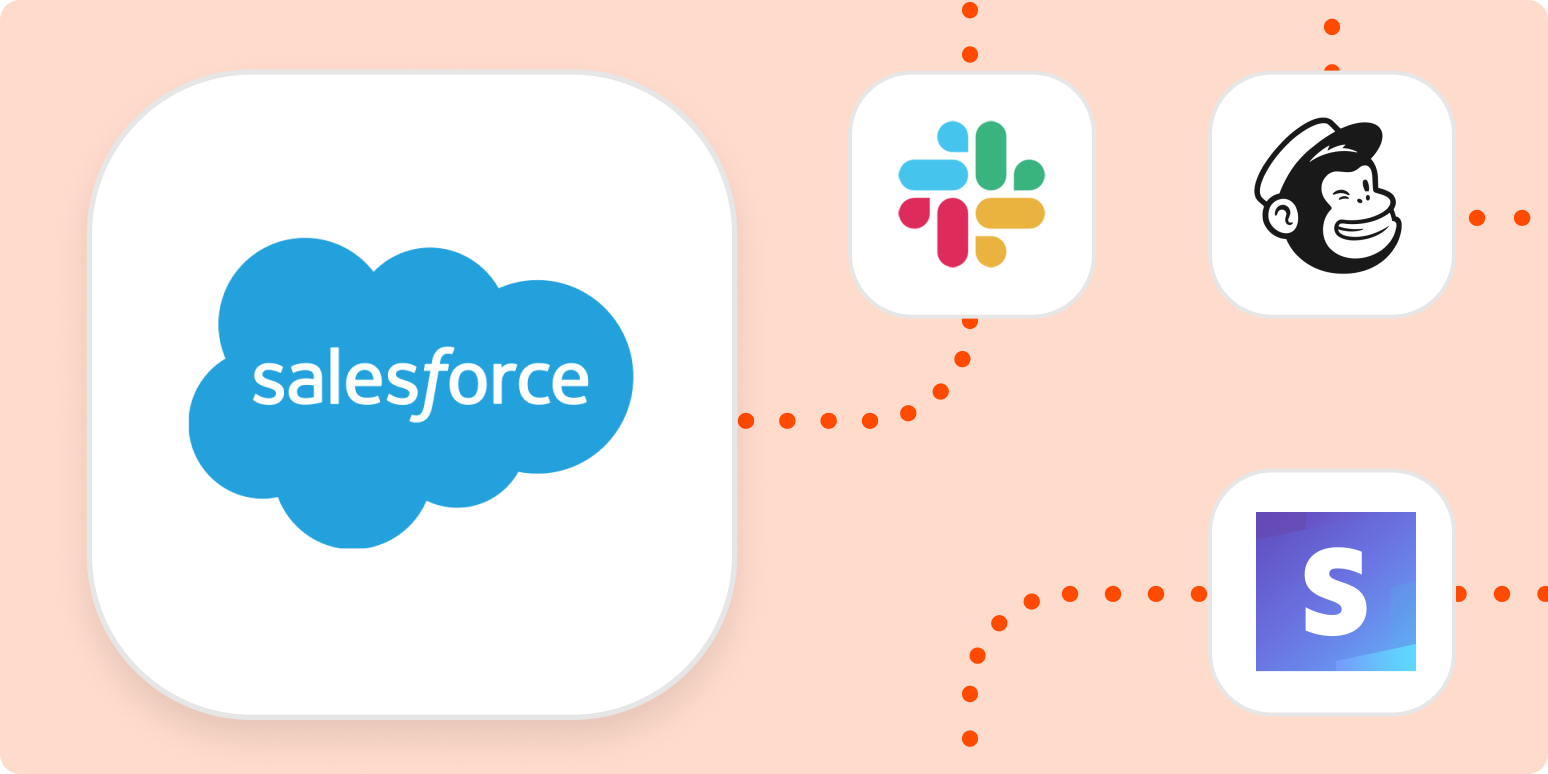Many teams across the world—especially sales teams—spend the majority of their working day in Salesforce. This popular customer relationship management (CRM) platform houses an enormous amount of data, including all of your customers’ contact information, the products they’ve purchased in the past, lead tracking information, and the status of sales opportunities.
This treasure trove of information, however, can be difficult to wrangle. Experian reports that human error is the most common cause of inaccurate data, and 91% of businesses suffer from common data errors.
Humans using complex tools like Salesforce need a little help to keep things running efficiently, and make it less likely anyone will accidentally duplicate, delete, or alter important information. Integrating Zapier and Salesforce makes this possible.
How you can integrate Salesforce with just about any app using Zapier
Don’t manage or move around your data in Salesforce by hand. Use Zaps—Zapier’s automated workflows—to automatically transfer information between Salesforce and other apps you use every day, like Gmail, Shopify, and ActiveCampaign.
Zaps are made up of triggers and actions: Triggers (like “A Salesforce contact emails customer support”) tell a Zap to do something in an action (update the Salesforce contact record with the email logged on Zendesk). Zaps connect two or more apps together, and can be sent in either direction, so you can update Salesforce with data from somewhere else, or tell other apps to perform a certain task after something happens in Salesforce.
Here are a few examples of Salesforce Zaps in practice:
-
When a new task is created in Salesforce and assigned to you, have a Zap create a task in your task management tool of choice, like Trello, so you don’t lose track of it
Using Zapier and Salesforce together saves you time by automating workflows that would otherwise invite the potential for human error or simply waste your team’s time.
To get started using Zapier and Salesforce together, you’ll need:
-
An account with Salesforce
-
A premium Zapier account (or be in your initial two-week trial period)
-
Accounts with the apps you want to automate, such as your ads platform or accounting system
-
Login/admin permissions needed (if any) to authorize integrations between these apps
Ready to save time managing your leads? Here are four Salesforce automation ideas that can help you get the most out of your CRM.
-
Never manually create leads or contacts
-
Effortlessly track warm leads and opportunities
-
Connect Salesforce with to-do list apps
-
Keep sales and financial data in sync
Never manually create a new lead or contact again
When someone clicks on an online ad or fills out a form, how do you make sure that person ends up in Salesforce? Do you manually download their information, reformat it, and upload it into Salesforce, losing valuable to-the-second tracking information about their activity? Do you sit down and type their details into your CRM by hand, inviting in human error?
Manual lead management is a huge time-waster, and the misery multiplies the more leads you have. Save time by automating lead data sharing. Here are a few Zapier and Salesforce automation ideas that will do the trick:
Effortlessly track warm leads and opportunities
When a new lead comes in, you often have only minutes to reach out if you want to convert them into paying customers. Staying on top of new leads in real-time can be frustrating, especially when you’re trying to track hundreds or thousands of sales opportunities.
A great solution to this problem is to push new leads into whatever chat app your team uses. That way, they can immediately see when a new lead comes in, along with the relevant contact information they need to reach out. Here are a couple of Zaps that can do this:
Stay on top of Salesforce tasks with your favorite to-do app
Salesforce offers a create task feature that allows you to associate tasks with leads or assign them to specific people on your team. Some teams have these automatically set up within Salesforce, and some sales managers prefer tracking their team’s work activity by monitoring tasks.
But not everyone wants to manage their tasks in Salesforce directly, especially folks with their own method for managing their to-do list.
Instead of manually copying your Salesforce tasks into your favorite to-do app, here are a couple of Zaps that can do it for you:
Keep your sales data and financial data in sync
Another area where many businesses can save time is in keeping their accounting app up-to-date based on the most recent Salesforce data. When a new contact or opportunity is created in Salesforce, you’ll eventually also need to create a corresponding contact or customer in your accounting program. Similarly, when a Salesforce opportunity closes, you’ll have to create an invoice for that amount in your financial hub.
That’s a lot of data entry to ask of your sales and accounting staff, so here are a few Salesforce automation ideas that can lighten the load:
Navigate your network of contacts with Zapier and Salesforce
Keeping your CRM tidy is a never-ending task, and never-ending tasks are exactly the types of tasks you need to automate. Using Zapier and Salesforce together to keep your data clean and organized will make tracking leads and closing deals that much simpler. Get to know about your customers by implementing salesforce feedback management.
Love these automations, but not sure how to get started with Zapier? Learn more about setting up your apps to work together with Zapier.
This article was originally written by Zapier staff writer Hannah Herman and published in November 2019. It was updated in August 2021 by Joanna Rutter.
[adsanity_group align=’alignnone’ num_ads=1 num_columns=1 group_ids=’15192′]
Need Any Technology Assistance? Call Pursho @ 0731-6725516







